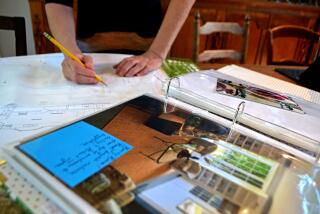REMODELING : Cleaning Up Around the House
- Share via
For years, Joyce Hays of Orange got through life with what she called “the bowling alley”--a narrow strip of space next to her bed that had a small, makeshift sink and counter and led to a tiny room that barely contained a commode and tub.
“It wasn’t much of a ‘master’ bath. Showering in that small space felt claustrophobic, and the vanity had very little counter or drawer space,” says Hays, a teacher.
Then last year she turned the bowling alley around, moving the fixtures to allow more room to get in and out, adding a whirlpool tub and installing a user-friendly vanity.
“It’s less of a cubbyhole; you feel like you’re in a real bathroom now.”
Hays’ predicament is not unlike that faced by many homeowners who have bought homes with little bathroom space.
“With interest rates and property values down, lots of people are finding it’s cheaper to buy a small tract home than rent an apartment,” says plumber Bill Grimes of Fullerton. “But many of these older homes built in the 1950s have two or even three bedrooms and one hall bathroom, which is often small or poorly designed.”
Changing a bad bathroom into a good one requires ingenuity, not necessarily a large checking account.
“You have to really examine what bothers you about your bathroom,” Grimes says. “Maybe the sink is slow or the toilet doesn’t work right. If you fix up a few little things and add a new medicine chest and paint job, you might find you like your bathroom.”
A new, lighter shade on the walls can add to a feeling of more space, as can mirrors and clear glass enclosures surrounding a bath or shower. Mirrors bring more light to the room and make it appear larger, and clear glass allows a good view of the shower or bath stall, making it a part of the room rather than partitioned from it.
Another common complaint is the bathroom door that opens to the wrong side, toward the toilet instead of the wall. If the door is turned around and the hinges are installed on the opposite side of the jamb, getting in and out of a small bathroom could be easier.
Expanding the bathroom’s size is more complicated than simply changing the fixtures or painting, but it will make a sweeping improvement.
“Knocking out a wall could mean taking space away from another room for your bathroom if you’re not building an addition to the house,” Grimes says. “But if the bathroom is adjacent to an unused bedroom closet, that may be enough extra space to get rid of the claustrophobia.”
*
Living in a one-bath house can be inconvenient for those with a growing household. The question that surrounds the addition of another bathroom in a small house is generally: where? If you’re trying to cut costs and create a bathroom without expanding, finding the space can be difficult.
“Most of these older homes had the bathroom in a central location, like the hall. But nowadays most people like the concept of a master bedroom and bath,” says Rich Haagsma of Faucets n’ Fixtures in Orange. “In some cases, you can turn a closet area into a small bathroom with a toilet, space-saving pedestal sink and stall shower, then add a sliding door to save more space.”
This could require using an armoire to store clothing, but if the space works, a bathroom-for-closet exchange might fill your needs. “Your home only has so much space, and if you’re not expanding the size, something’s got to give,” Grimes says.
Smaller fixtures are a requirement when furnishing a mini- bath. A regular, rather than an elongated, toilet with a short tank, recessed lighting, medicine chest and towel bars can help keep protrusions in a small space to a minimum. A modest vanity to contain only the essentials can be built around a small sink.
Forget wild thoughts of creating an airplane-sized lavatory or an RV bathroom/shower; a new bathroom must meet building code specifications for floor space. A full bath with a standard tub/shower, sink and toilet is 5 feet by 7 or 8 feet. For a half-bath, one could get away with a space of 30 inches by 4 1/2 feet for a toilet and pedestal sink.
If your home has a laundry porch, this is also a potential spot for an additional bathroom. The washer and dryer can be moved to the garage, and the bathroom fixtures put into place. Many older two-story homes have closets built under staircases, which could creatively be turned into bathrooms.
Many homes built before the 1960s were set on raised foundations, which makes plumbing alterations easier.
“Being able to get underneath the house to move pipes around is a big advantage,” Haagsma says. “That space between the ground and the house floor is important when you’re trying to configure a pipe that will run from the new bathroom to the sewer.”
*
Drain pipes must run to the sewer line with a down slope of a quarter-inch per foot.
“With a raised foundation, getting the right down slope is never a worry, which is a big plus when you’re planning a bathroom, since figuring out the drainage is one of the first problems you’re confronted with,” says Scott Blanke of Central Plumbing & Heating Supply in La Habra.
New and remodeled bathrooms must also be rewired with ground fault interruption electrical circuitry to prevent fire hazards. And if your new bath has no wall to the exterior of your house, you’ll have to devise a way to install a vent in place of a window.
Adding a new bath is a major undertaking, which is why it’s on the dream list of many homeowners.
Paul and Mary Zamora of Anaheim were recently pricing fixtures at a plumbing supply store, looking for ideas for the day they add a second bathroom to their one bath home.
“Ideally, we’d want to put a master bedroom and bath in, using up some space in the backyard,” says Mary, an accountant. “But the cost of building is so high, right now we’re still in the dream stage.”
Says Paul, a computer programmer: “I’m a little more determined. I don’t think we have to put off this addition too long. If we do the basic framing, electrical and plumbing work ourselves, we can save [money] because the raw materials aren’t that expensive. I want to get beyond the dream stage. I can feel the water from that new shower already.”


